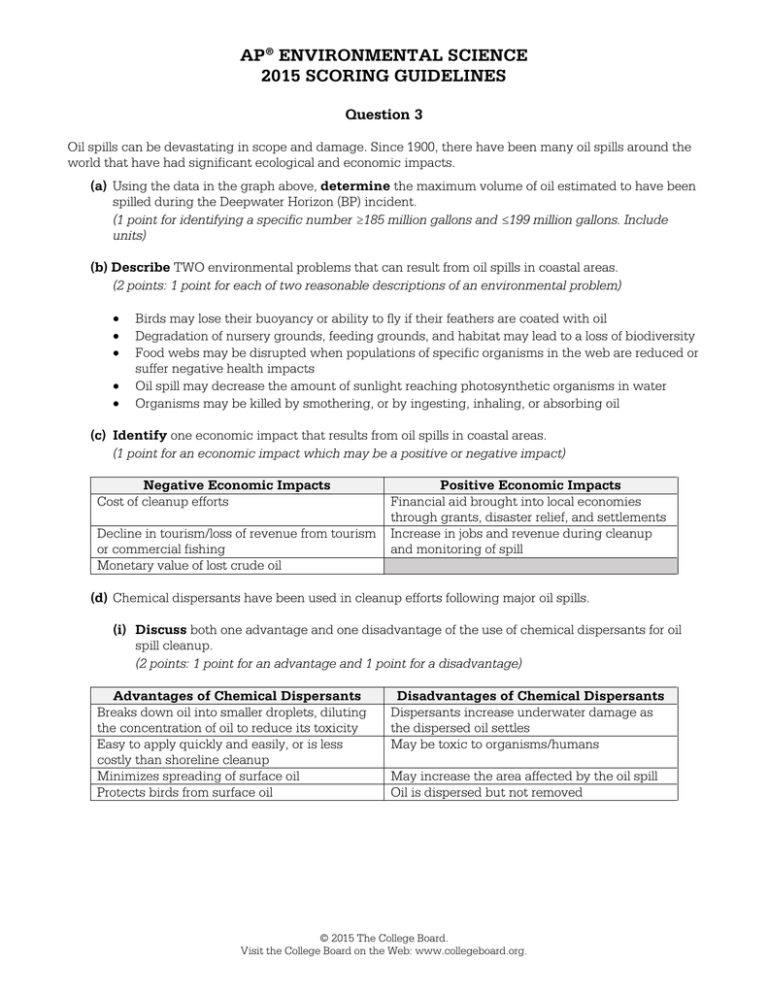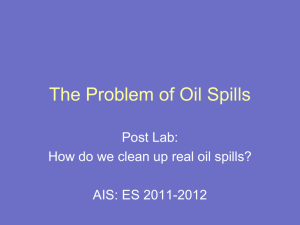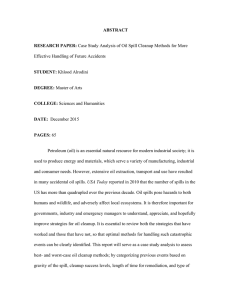ap® environmental science 2015 scoring guidelines
advertisement

AP® ENVIRONMENTAL SCIENCE 2015 SCORING GUIDELINES Question 3 Oil spills can be devastating in scope and damage. Since 1900, there have been many oil spills around the world that have had significant ecological and economic impacts. (a) Using the data in the graph above, determine the maximum volume of oil estimated to have been spilled during the Deepwater Horizon (BP) incident. (1 point for identifying a specific number ≥185 million gallons and ≤199 million gallons. Include units) (b) Describe TWO environmental problems that can result from oil spills in coastal areas. (2 points: 1 point for each of two reasonable descriptions of an environmental problem) • • • • • Birds may lose their buoyancy or ability to fly if their feathers are coated with oil Degradation of nursery grounds, feeding grounds, and habitat may lead to a loss of biodiversity Food webs may be disrupted when populations of specific organisms in the web are reduced or suffer negative health impacts Oil spill may decrease the amount of sunlight reaching photosynthetic organisms in water Organisms may be killed by smothering, or by ingesting, inhaling, or absorbing oil (c) Identify one economic impact that results from oil spills in coastal areas. (1 point for an economic impact which may be a positive or negative impact) Negative Economic Impacts Cost of cleanup efforts Decline in tourism/loss of revenue from tourism or commercial fishing Monetary value of lost crude oil Positive Economic Impacts Financial aid brought into local economies through grants, disaster relief, and settlements Increase in jobs and revenue during cleanup and monitoring of spill (d) Chemical dispersants have been used in cleanup efforts following major oil spills. (i) Discuss both one advantage and one disadvantage of the use of chemical dispersants for oil spill cleanup. (2 points: 1 point for an advantage and 1 point for a disadvantage) Advantages of Chemical Dispersants Breaks down oil into smaller droplets, diluting the concentration of oil to reduce its toxicity Easy to apply quickly and easily, or is less costly than shoreline cleanup Minimizes spreading of surface oil Protects birds from surface oil Disadvantages of Chemical Dispersants Dispersants increase underwater damage as the dispersed oil settles May be toxic to organisms/humans May increase the area affected by the oil spill Oil is dispersed but not removed © 2015 The College Board. Visit the College Board on the Web: www.collegeboard.org. AP® ENVIRONMENTAL SCIENCE 2015 SCORING GUIDELINES Question 3 (continued) (ii) Identify either one biological or one physical method (other than chemical dispersal) used for oil spill cleanup in coastal waters or on beaches and describe how the method is used. (1 point for description of an acceptable method) Biological Method Introduction of microbes that degrade the oil Physical Methods Burning oil on the surface of water Dredging and vacuuming to remove oil Physical washing of rocks/organisms Use of absorbent material to remove oil or to keep the spill from spreading Using booms to contain oil on the surface and skimmers to separate the oil from the water (e) Catastrophic spills make up less than 20 percent of the oil that pollutes marine waters. Identify one other source of oil contamination and explain how the oil from this source enters marine waters. (2 points: 1 point for identification of a source, and 1 point for an explanation of how oil from that source enters the water) Source Leaks from oil infrastructure Oil from boats Natural seeps Oil from automobiles Oil intentionally dumped Explanation Leaks can occur during the exploration, production, and transport of oil Oil can leak from boat engines and during the emptying of bilge tanks Crude oil leaks to the surface naturally from the ocean floor Oil dripped from cars can be washed into water with storm runoff Oil is then carried to water with runoff or directly dumped into the water (f) Petroleum has many uses as a raw material for consumer goods. Identify one substitute for petroleum in a specific consumer product (other than fuel). (1 point for identification of a reasonable substitute for petroleum in a product) • • • • Paper bags Corn-based plastic water bottles Bamboo or wood storage containers Natural fibers (cotton, hemp, bamboo, etc.) in garments, upholstery, etc. © 2015 The College Board. Visit the College Board on the Web: www.collegeboard.org. ©2015 The College Board. Visit the College Board on the Web: www.collegeboard.org. ©2015 The College Board. Visit the College Board on the Web: www.collegeboard.org. ©2015 The College Board. Visit the College Board on the Web: www.collegeboard.org. ©2015 The College Board. Visit the College Board on the Web: www.collegeboard.org. ©2015 The College Board. Visit the College Board on the Web: www.collegeboard.org. ©2015 The College Board. Visit the College Board on the Web: www.collegeboard.org. ©2015 The College Board. Visit the College Board on the Web: www.collegeboard.org. ©2015 The College Board. Visit the College Board on the Web: www.collegeboard.org. AP® ENVIRONMENTAL SCIENCE 2015 SCORING COMMENTARY Question 3 Overview The intent of this question was to determine knowledge level regarding oil spills and oil spill cleanups. The question required the student interpret a graph, discuss problems associated with oil spills, discuss the advantages and disadvantages of oil spill response methods, explain other ways that oil enters aquatic ecosystems, and to identify a replacement for petroleum in consumer goods. Sample: 3A Score: 10 One point was earned in part (a) for correctly determining the maximum oil volume spilled during the “BP” oil spill to be 190 million gallons. Two points were earned in part (b): 1 point for a description of the impact of oil spills on birds and 1 point for a description of the disruption of food webs by oil spills. One point was earned in part (c) for a description of the decline in tourism due to oil spills. Two points were earned in part (d)(i): 1 point for discussion of dispersants breaking down oil and 1 point for discussion of the increased difficulty of oil removal following the application of dispersants. One point was earned in (d)(ii) for describing the microbial breakdown of oil. Two points were earned in part (e): 1 point for identification of automobile leaks and 1 point for describing runoff as the process that carried the oil to the ocean. One point was earned in part (f) for discussing paper as a replacement for petroleum-based plastic in packaging materials. Sample: 3B Score: 8 One point was earned in part (a) for correctly determining the maximum oil volume oil spilled during the “BP” oil spill to be 190 million gallons. Two points were earned in part (b): 1 point for a description of the damage that is done to fish gills and 1 point for the impact on bird feathers and the ability to fly. One point was earned in part (c) for describing the monetary cost of oil spill cleanup. Two points were earned in part (d): 1 point in part (d)(i) for discussion of the toxicity of dispersants to marine life and 1 point in (d)(ii) for describing vacuuming as a physical method of oil spill cleanup. Two points were earned in part (e): 1 point for identification of automobiles as an oil source and 1 point for the description of runoff as the process that carried oil to the ocean. No points were earned in part (f). Sample: 3C Score: 6 No points were earned in part (a). One point was earned in part (b) for describing the smothering of birds by oil. One point was earned in part (c) for describing the monetary cost of oil spill cleanup. One point was earned in (d)(ii) for describing the potential toxicity of dispersants and its impact on living organisms. One point was earned in (d)(ii) for describing a physical method for cleaning oil spills. Two points were earned in part (e) for describing intentional dumping as a source and description of oil entering the ocean. © 2015 The College Board. Visit the College Board on the Web: www.collegeboard.org.



